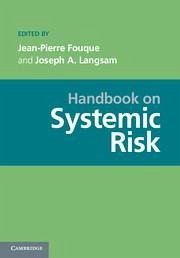Handbook on Systemic Risk
Herausgeber: Fouque, Jean-Pierre; Langsam, Joseph A
Handbook on Systemic Risk
Herausgeber: Fouque, Jean-Pierre; Langsam, Joseph A
- Gebundenes Buch
- Merkliste
- Auf die Merkliste
- Bewerten Bewerten
- Teilen
- Produkt teilen
- Produkterinnerung
- Produkterinnerung
Experts in the field provide an introduction to the multifaceted aspects of this critically important topic.
Andere Kunden interessierten sich auch für
![Handbook for Applied Modeling: Non-Gaussian and Correlated Data Handbook for Applied Modeling: Non-Gaussian and Correlated Data]() Jamie D RiggsHandbook for Applied Modeling: Non-Gaussian and Correlated Data120,99 €
Jamie D RiggsHandbook for Applied Modeling: Non-Gaussian and Correlated Data120,99 €![Risk Management and Value: Valuation and Asset Pricing Risk Management and Value: Valuation and Asset Pricing]() Risk Management and Value: Valuation and Asset Pricing217,99 €
Risk Management and Value: Valuation and Asset Pricing217,99 €![Quantitative Reasoning Quantitative Reasoning]() Eric ZaslowQuantitative Reasoning74,99 €
Eric ZaslowQuantitative Reasoning74,99 €![Evaluating What Works Evaluating What Works]() Dorothy V M BishopEvaluating What Works161,99 €
Dorothy V M BishopEvaluating What Works161,99 €![Palo Alto school Palo Alto school]() Taqiyeddine YAHIAPalo Alto school29,99 €
Taqiyeddine YAHIAPalo Alto school29,99 €![Starting Statistics Starting Statistics]() Neil BurdessStarting Statistics159,99 €
Neil BurdessStarting Statistics159,99 €![Advances in Coding Theory and Cryptography Advances in Coding Theory and Cryptography]() T Shaska / W C Huffman / D Joyner / V Ustimenko (eds.)Advances in Coding Theory and Cryptography121,99 €
T Shaska / W C Huffman / D Joyner / V Ustimenko (eds.)Advances in Coding Theory and Cryptography121,99 €-
-
-
Experts in the field provide an introduction to the multifaceted aspects of this critically important topic.
Hinweis: Dieser Artikel kann nur an eine deutsche Lieferadresse ausgeliefert werden.
Hinweis: Dieser Artikel kann nur an eine deutsche Lieferadresse ausgeliefert werden.
Produktdetails
- Produktdetails
- Verlag: Cambridge University Press
- Seitenzahl: 992
- Erscheinungstermin: 15. Juli 2013
- Englisch
- Abmessung: 254mm x 177mm x 45mm
- Gewicht: 1857g
- ISBN-13: 9781107023437
- ISBN-10: 1107023432
- Artikelnr.: 38480349
- Herstellerkennzeichnung
- Libri GmbH
- Europaallee 1
- 36244 Bad Hersfeld
- gpsr@libri.de
- Verlag: Cambridge University Press
- Seitenzahl: 992
- Erscheinungstermin: 15. Juli 2013
- Englisch
- Abmessung: 254mm x 177mm x 45mm
- Gewicht: 1857g
- ISBN-13: 9781107023437
- ISBN-10: 1107023432
- Artikelnr.: 38480349
- Herstellerkennzeichnung
- Libri GmbH
- Europaallee 1
- 36244 Bad Hersfeld
- gpsr@libri.de
Introduction; Contributors; Part I. Data: The Prerequisite for Managing
Systemic Risk: 1. Systemic risk information requirements: current
environment, needs, and approaches for development; 2. Aligning models and
data for systemic risk analysis; 3. Applying FpML; 4. Data integration for
systemic risk in the financial system; 5. Semantics in systemic risk
management; Part II. Statistics and Systemic Risk: 6. Statistical
assessments of systemic risk measures; 7. Regime switching models and risk
measurement tools; Part III. Measuring and Regulating Systemic Risk: 8.
Measuring systemic risk; 9. Taxing systemic risk; 10. Analyzing systemic
risk of the European banking sector; Part IV. Networks: 11. Network models
and systemic risk assessment; 12. Strategic interactions on financial
networks for the analysis of systemic risk; 13. Network structure and
systemic risk in banking systems; Part V. Systemic Risk and Mathematical
Finance: 14. Firms, banks and households; 15. An agent-based computational
model for bank formation and interbank networks; 16. Diversification in
financial networks may increase systemic risk; 17. Systemic risk
illustrated; 18. Financial crisis and contagion: a dynamical systems
approach; Part VI. Counterparty Risk and Systemic Risk: 19. Pricing and
mitigation of counterparty credit exposures; 20. Counterparty contagion in
context: contributions to systemic risk; Part VII. Algorithmic Trading: 21.
Market microstructure knowledge needed for controlling an intra-day trading
process; 22. Dynamical models of market impact and algorithms for order
execution; Part VIII. Behavioral Finance: The Psychological Dimension of
Systemic Risk: 23. Fear, greed, and financial crises: a cognitive
neurosciences perspective; 24. Bubbles, crises, and heterogeneous beliefs;
25. Systemic risk and sentiment; Part IX. Regulation: 26. The new financial
stability framework in Europe; 27. Sector-level financial networks and
macroprudential risk analysis in the Euro area; 28. Systemic risk early
warning system: a micro-macro prudential synthesis; Part X. Computational
Issues and Requirements: 29. Enabling data analysis for addressing systemic
risk; 30. Operational considerations in an analytic environment for
systemic risk; 31. Requirements for systemic risk management in the
financial sector; Part XI. Accounting Issues: 32. Accounting's role in the
reporting, creation, and avoidance of systemic risk in financial
institutions.
Systemic Risk: 1. Systemic risk information requirements: current
environment, needs, and approaches for development; 2. Aligning models and
data for systemic risk analysis; 3. Applying FpML; 4. Data integration for
systemic risk in the financial system; 5. Semantics in systemic risk
management; Part II. Statistics and Systemic Risk: 6. Statistical
assessments of systemic risk measures; 7. Regime switching models and risk
measurement tools; Part III. Measuring and Regulating Systemic Risk: 8.
Measuring systemic risk; 9. Taxing systemic risk; 10. Analyzing systemic
risk of the European banking sector; Part IV. Networks: 11. Network models
and systemic risk assessment; 12. Strategic interactions on financial
networks for the analysis of systemic risk; 13. Network structure and
systemic risk in banking systems; Part V. Systemic Risk and Mathematical
Finance: 14. Firms, banks and households; 15. An agent-based computational
model for bank formation and interbank networks; 16. Diversification in
financial networks may increase systemic risk; 17. Systemic risk
illustrated; 18. Financial crisis and contagion: a dynamical systems
approach; Part VI. Counterparty Risk and Systemic Risk: 19. Pricing and
mitigation of counterparty credit exposures; 20. Counterparty contagion in
context: contributions to systemic risk; Part VII. Algorithmic Trading: 21.
Market microstructure knowledge needed for controlling an intra-day trading
process; 22. Dynamical models of market impact and algorithms for order
execution; Part VIII. Behavioral Finance: The Psychological Dimension of
Systemic Risk: 23. Fear, greed, and financial crises: a cognitive
neurosciences perspective; 24. Bubbles, crises, and heterogeneous beliefs;
25. Systemic risk and sentiment; Part IX. Regulation: 26. The new financial
stability framework in Europe; 27. Sector-level financial networks and
macroprudential risk analysis in the Euro area; 28. Systemic risk early
warning system: a micro-macro prudential synthesis; Part X. Computational
Issues and Requirements: 29. Enabling data analysis for addressing systemic
risk; 30. Operational considerations in an analytic environment for
systemic risk; 31. Requirements for systemic risk management in the
financial sector; Part XI. Accounting Issues: 32. Accounting's role in the
reporting, creation, and avoidance of systemic risk in financial
institutions.
Introduction; Contributors; Part I. Data: The Prerequisite for Managing
Systemic Risk: 1. Systemic risk information requirements: current
environment, needs, and approaches for development; 2. Aligning models and
data for systemic risk analysis; 3. Applying FpML; 4. Data integration for
systemic risk in the financial system; 5. Semantics in systemic risk
management; Part II. Statistics and Systemic Risk: 6. Statistical
assessments of systemic risk measures; 7. Regime switching models and risk
measurement tools; Part III. Measuring and Regulating Systemic Risk: 8.
Measuring systemic risk; 9. Taxing systemic risk; 10. Analyzing systemic
risk of the European banking sector; Part IV. Networks: 11. Network models
and systemic risk assessment; 12. Strategic interactions on financial
networks for the analysis of systemic risk; 13. Network structure and
systemic risk in banking systems; Part V. Systemic Risk and Mathematical
Finance: 14. Firms, banks and households; 15. An agent-based computational
model for bank formation and interbank networks; 16. Diversification in
financial networks may increase systemic risk; 17. Systemic risk
illustrated; 18. Financial crisis and contagion: a dynamical systems
approach; Part VI. Counterparty Risk and Systemic Risk: 19. Pricing and
mitigation of counterparty credit exposures; 20. Counterparty contagion in
context: contributions to systemic risk; Part VII. Algorithmic Trading: 21.
Market microstructure knowledge needed for controlling an intra-day trading
process; 22. Dynamical models of market impact and algorithms for order
execution; Part VIII. Behavioral Finance: The Psychological Dimension of
Systemic Risk: 23. Fear, greed, and financial crises: a cognitive
neurosciences perspective; 24. Bubbles, crises, and heterogeneous beliefs;
25. Systemic risk and sentiment; Part IX. Regulation: 26. The new financial
stability framework in Europe; 27. Sector-level financial networks and
macroprudential risk analysis in the Euro area; 28. Systemic risk early
warning system: a micro-macro prudential synthesis; Part X. Computational
Issues and Requirements: 29. Enabling data analysis for addressing systemic
risk; 30. Operational considerations in an analytic environment for
systemic risk; 31. Requirements for systemic risk management in the
financial sector; Part XI. Accounting Issues: 32. Accounting's role in the
reporting, creation, and avoidance of systemic risk in financial
institutions.
Systemic Risk: 1. Systemic risk information requirements: current
environment, needs, and approaches for development; 2. Aligning models and
data for systemic risk analysis; 3. Applying FpML; 4. Data integration for
systemic risk in the financial system; 5. Semantics in systemic risk
management; Part II. Statistics and Systemic Risk: 6. Statistical
assessments of systemic risk measures; 7. Regime switching models and risk
measurement tools; Part III. Measuring and Regulating Systemic Risk: 8.
Measuring systemic risk; 9. Taxing systemic risk; 10. Analyzing systemic
risk of the European banking sector; Part IV. Networks: 11. Network models
and systemic risk assessment; 12. Strategic interactions on financial
networks for the analysis of systemic risk; 13. Network structure and
systemic risk in banking systems; Part V. Systemic Risk and Mathematical
Finance: 14. Firms, banks and households; 15. An agent-based computational
model for bank formation and interbank networks; 16. Diversification in
financial networks may increase systemic risk; 17. Systemic risk
illustrated; 18. Financial crisis and contagion: a dynamical systems
approach; Part VI. Counterparty Risk and Systemic Risk: 19. Pricing and
mitigation of counterparty credit exposures; 20. Counterparty contagion in
context: contributions to systemic risk; Part VII. Algorithmic Trading: 21.
Market microstructure knowledge needed for controlling an intra-day trading
process; 22. Dynamical models of market impact and algorithms for order
execution; Part VIII. Behavioral Finance: The Psychological Dimension of
Systemic Risk: 23. Fear, greed, and financial crises: a cognitive
neurosciences perspective; 24. Bubbles, crises, and heterogeneous beliefs;
25. Systemic risk and sentiment; Part IX. Regulation: 26. The new financial
stability framework in Europe; 27. Sector-level financial networks and
macroprudential risk analysis in the Euro area; 28. Systemic risk early
warning system: a micro-macro prudential synthesis; Part X. Computational
Issues and Requirements: 29. Enabling data analysis for addressing systemic
risk; 30. Operational considerations in an analytic environment for
systemic risk; 31. Requirements for systemic risk management in the
financial sector; Part XI. Accounting Issues: 32. Accounting's role in the
reporting, creation, and avoidance of systemic risk in financial
institutions.








